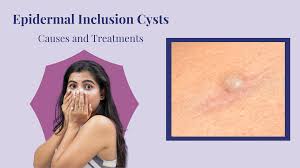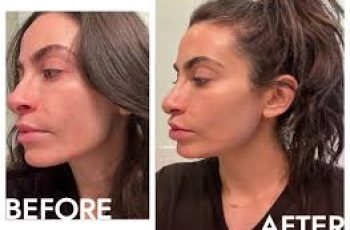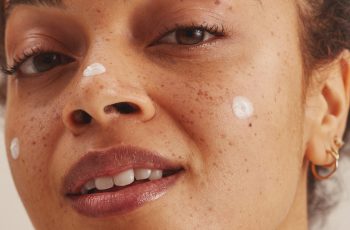
Epidermal Inclusion Cyst
In my dermatology practice, one of the most common skin conditions I see are epidermal inclusion cysts,(also called blind pimple, acne nodules, acne cysts or sebaceous cysts). These hard bumps under the skin can be frustrating and painful, so I want to provide some guidance on how to identify, prevent, and treat these pesky cysts.
Not all acne nodules are cysts, but the ones that last months and won’t go away are usually cysts.
If you get a lot of cysts, you are not using the best skin care routine for your skin type. There are 16 Baumann Skin Types. Take the skin care routine quiz and we can help you build a skin care routine to prevent cysts.
Other Names for Epidermal Inclusion Cyst
An epidermal inclusion cyst (EIC) is known as an epidermoid cyst, epidermal cyst, or a sebaceous cyst These are all the same thing; a benign hard papule or nodule in the dermis and subcutaneous tissue. It may be also called be called a blind pimple but it is more correct to say EIC.
Sebaceous Cyst
A sebaceous cyst is the incorrect name for an epidermal inclusion cyst. Years ago it was believed these contained sebum but we now know these are the same as an EIC. (1)
Epidermoid Cyst
Epidermoid cysts are essentially the same condition as Epidermal Inclusion Cysts (EIC). They are slow-growing lumps that gently push up the skin. One distinct feature many notice is a small, central dot or opening on the cyst, which is known as a “punctum.” This punctum is the blocked opening of a hair follicle and its associated oil gland, called the pilosebaceous follicle.
The name difference might be confusing, but whether you hear “Epidermoid cyst” or “EIC,” know that they are referring to the same skin condition. Both terms describe benign (non-cancerous) growths that originate from the skin’s outermost layer and its associated structures. They’re commonly filled with a combination of skin cells and proteins, giving them a cheesy or pasty consistency if ever opened.
How To Diagnose
How to identify a cyst? Your dermatologist can usually diagnose an EIC by looking at it with a dermatoscope and hearing the history of the bump.
When these are excised, they will be sent to a pathologist if your doctor is concerned about the lesion, because they can be cancer or other skin issues- but this is very rare. The presence of the smelly keratin discharge is a comforting sign of it being benign and not dangerous.
Many things can cause a hard bump or pimple under the skin.
This is the differential diagnosis of what I rule out when I see a hard bump under the skin in my dermatology patients:
Epidermal inclusion cyst – Firm, round nodules under the skin filled with keratin. May increase and decrease in size several times.
Lipoma – Soft rubbery nodules under the skin made up of fat cells. Can occur anywhere on the body. Stays the same size or gets bigger.
Dermatofibroma – Hard, round bumps on the skin, often on the legs. Centers tend to dimple when pressed. Can be hereditary. Can stay the same size but these usually get bigger.
Pilar cyst – Smooth, firm bumps under the scalp, filled with keratin. Can sometimes feel like hard marble.
Of these, when my patients complain of a blind pimple, they usually have an epidermal inclusion cyst.
Studies are usually not necessary but can be done to diagnose an epidermoid cyst.
diagnosing a cyst
Ultrasound and MRI
When your dermatologist cannot tell if the lesion is a EIC or when it is in a dangerous area such as the midline of the upper face or near large arteries, understanding what’s going on under the skin’s surface can help the doctor diagnose the cyst. They may turn to imaging techniques like ultrasound and MRI to get a better look.
Let’s break down what these tests might reveal if you had an epidermal cyst.
On Ultrasound:
Shape & Structure: Epidermal cysts usually appear as round or oval shapes.
Clear Boundaries: They have clear, defined edges, which in medical jargon is described as “well-circumscribed.”
No Blood Flow: These cysts typically don’t have blood vessels in them, which means they’re “avascular.”
Position: They’re often found just below the skin, in what’s called the subcutaneous tissue.
Dorsal Acoustic Amplification: This is a fancy way of saying that the ultrasound waves increase or “amplify” as they pass through the cyst. Imagine shouting into a cave and hearing your echo get louder!
Lateral Shadowing: This means that the sides of the cyst might cast a shadow or look darker on the ultrasound image.
On MRI:
T1-weighted images: On these specific types of MRI images, the cyst appears slightly darker than the surrounding tissue. This is described as “hypointense signal intensity.”
T2-weighted images: Here, the cyst might range from a medium shade to very bright, making it “intermediate to high signal.”
Restricted Diffusion: This means that water molecules within the cyst don’t move around as freely as they might in other tissues. This is a hallmark feature of epidermal cysts.
Why This Matters: Understanding these signs is crucial because they help doctors tell the difference between harmless epidermal cysts and potentially harmful growths or tumors (called “neoplastic lesions”).
EIC Under A Microscope
When biopsied or excised and looked at under the microscope, a EIC consists of a cystic space lined by keratinizing squamous epithelium. It is filled with laminated keratinaceous material. The cyst wall is composed of true epidermis with granular layer and contains keratin.
Epidermal inclusion cyst under microscope
Why So Hard To Get Rid Of?
Because it has a true epidermis that makes keratin, an EIC will almost always recur if the epidermal lining (capsule) is not removed.
So if you pop these and extrude the smelly keratin, but you do not remove the lining, the keratin build back up. Think of it as a balloon in the skin that keeps refilling itself.
This is why surgery is the most effective option to remove these.
Why do epidermal cysts happen?
Why Do I Get Cysts on My Skin?
EICs form when surface epidermis becomes embedded into the dermis from trauma such as picking acne lesions or trying to pop a pimple incorrectly and driving the pus and debris deeper into the skin.
The implanted epidermis continues to proliferate forming a walled off area that secretes keratin, and forms the cystic structure.
The cyst enlarges gradually as more keratin accumulates inside the lumen. The surrounding stroma can develop a foreign body reaction to the leaked keratin.
These cysts often arise from implantation of epidermis following trauma, surgery, or inflammation. They can also develop spontaneously. The slow accumulation of keratin leads to a painless subcutaneous nodule.
Using the right skin care products for your Baumann Skin Type can help prevent getting these cysts on the face.
Smelly white discharge from cysts
Keratin is the smelly white stuff that comes out of a cyst. It smells bad because of the skin bacteria that uses keratin as a never ending food source. The epidermal lining of sebaceous cysts keeps making more and more of the protein keratin. When the hard bump under your skin gets bigger, this is keratin building up inside the cyst. The thick stinky discharge of acne cysts is what has made the pimple Popper Videos so popular because opening them up can cause a dramatic smelly mess. Most of the pimple popping videos are not pimples but are actually epidermal inclusion cysts.
How To Get Rid of a Cyst
Cysts last for a long time (months to years) because they do not go away on their own, even if you try to drain it with a needle, draw it out or bring it to a head. How to remove a cyst depends upon where it is located and how large it is. EICS must be surgery removed in most cases. There are several ways to do this. I recommend that you see a dermatologist or plastic surgeon so you have the smallest scar possible. Keep reading to see all the ways to remove or get rid of cysts.
Treat EICs from Home
Never attempt to open these EICs yourself because:
They are deep and require incision into the dermis which causes scarring if done incorrectly
These often get infected because there is so much bacteria
These always come back if the entire capsule of the epidermal lining is not removed.
PIcking these epidermal cysts or trying to pop them can drive them deeper into the skin and cause scarring. This is a skin problem where you really need to see a dermatologist for treatment. Find one near you here.
How Your Doctor will Treat your EIC
Your doctor will do one of the following when you have an epidermal cyst:
Give you antibiotics if it is infected and reevaluate in a week or two.
Inject with a steroid like Kenalog to shrink the cyst
Open up the cyst an remove the keratin contents and scrape out the capsule.
Excise and stitch the entire cyst.
Excising the entire cyst is the best way to get rid of it permanently.
Which skin care routines prevent cysts?
Skin Care Routine To Prevent Cysts
You need to be on the right skin care routine for your Baumann Skin Type so that you are not making any of these skin care mistakes that cause cysts:
Over exfoliating
Using comedogenic ingredients
Using a moisturizer with the wrong fatty acids
Not treating acne correctly
Not using a retinoid
Using a retinoid such as a retinol is the best way to prevent EICs in most skin types. Here are some retinols that you can begin with, but it is best if you take the quiz so we can tell you all of the products you should use along with the retinol to prevent cysts.


